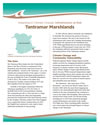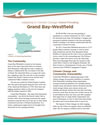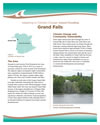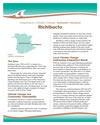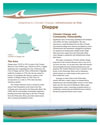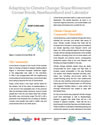Atlantic
The Atlantic case studies listed here were created or supported by CCIAD.
Each case study listing provides icons for quick topic reference, location, title, link and summary. A legend is also provided on the right.
Dykelands Infrastructure in Southeastern New Brunswick
(2012) (HTML, PDFs).
Recent concerns about rising sea levels, storm surges and heavy rains led to flooding, erosion, and damage to dykes. A series of reports on dykelands infrastructure was produced, along with three case studies:
- Tantramar Marshlands (PDF, 2.88 MB, 4 pages)
- Port Elgin (PDF, 1.41 MB, 2 pages)
- Memramcook (PDF, 1.51 MB, 2 pages)


Southeastern New Brunswick
Land Use and Flooding: Lower Saint John River Project
(2012) (HTML, PDFs).
This project used digital elevation modeling, and wet areas mapping (WAM) with Light Detection and Ranging (LiDAR) to visualize potential flood risks. The information gathered will be used in plans to protect infrastructure from localized flooding. A case study (Grand Bay-Westfield; PDF, 2.23 MB, 4 pages) was produced.


Grand Bay-Westfield, NB
Grand Falls Erosion Assessment Project
Richibucto Saltwater Intrusion Project
(2012) (HTML, PDFs).
Sea water is affecting the quality of groundwater used for drinking water supplies in the community. A project was undertaken to define current aquifer and groundwater conditions, and to forecast the effects of sea level rise. A case study (Richibucto; PDF, 1.24 MB, 2 pages) was produced.


Acadian Peninsula Coastal Erosion and Sea Level Rise Project
(2012) (HTML, PDFs).
A series of reports were created to assess future coastal erosion and sea level rise. Additionally, three case studies about how communities plan to better manage flooding and erosion were produced:
- Bas-Caraquet (PDF, 1MB, 2 pages)
- Shippagan (PDF, 2.08 MB, 3 pages)
- Le Goulet (PDF, 1.11 MB, 3 pages)

Greater Moncton Infrastructure Assessment Project
(2012) (HTML, PDFs).
The Greater Moncton Area has experienced infrastructure and wastewater management problems due to heavy rainfall events and flooding. This study evaluated current infrastructure and recommended adaptation measures. This process was highlighted in the following case studies:


Greater Moncton Area, NB
7 Steps to Assess Climate Change Vulnerability in Your Community
(2012) (HTML, PDFs).
Towards demonstrating the pilot testing of the 7 Steps to Assess Climate Change Vulnerability in Your Community Workbook, a series of case studies was produced on various adaptation topics:
- Slope Movement: Corner Brook (PDF, 1.38 MB, 4 pages)
- River Flooding: Indian Bay (PDF, 1.37 MB, 4 pages)
- Coastal Flooding: Ferryland (PDF, 4,55 MB, 4 pages)
- Coastal Erosion and Flooding: Logy Bay – Middle Cove
- Outer Cove (PDF, 1.4 MB, 4 pages)
- The cases studies above are complemented by the Managing Municipal Infrastructure in a Changing Climate Workbook.



Newfoundland and Labrador
Tantramar Dykelands Infrastructure at Risk - Sackville, New Brunswick
(2012) (PDF, 17 MB, 5 pages).
Describes a collaborative effort to determine which dykeland areas are most vulnerable to erosion or being overtopped by sea-level rise.


Placentia Water Resources Infrastructure
Vulnerability of Shelburne Sewage Treatment
Page details
- Date modified:
